Have you ever heard of spiders that are red and blue in color, but don’t know much about them? Then look no further. Today we’re going to be talking about these spectacular and unique species from around the world, each with its own interesting traits and behaviors.
We’ll take a close look at their appearance, size, and habitats, plus photos, this way you’ll know exactly how to identify them! So get ready to experience something truly remarkable as we explore 6 jaw-dropping red and blue spiders together.
1. Red-Headed Mouse Spider
The Red-Headed Mouse Spider (Missulena occatoria) is a fascinating arachnid species native to Australia. As its name suggests, one of the most distinctive characteristics of this spider is its bright red head and jaws, known as chelicerae.
However, it’s not just their redhead and jaws that stand out! They also have a dark blue abdomen and black legs that give this spider a particularly striking appearance.
The males typically have a body length of 15mm, and a pair of large, forward-facing fangs. Whereas the female Red-Headed Mouse Spiders are less colorful.
Females are also much larger than males, measuring up to 35 mm in body length. Their entire body has a more glossy black and blue color, lacking the redhead that makes the males so recognizable.
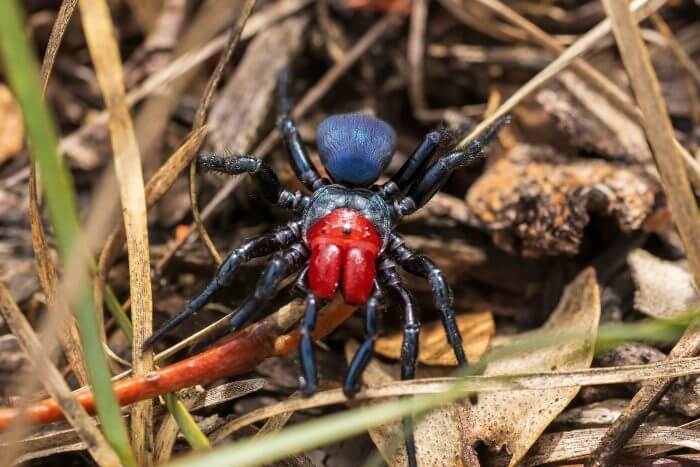
Like other spiders in the Missulena genus, they have a robust build with a stout carapace and abdomen. Their eight legs are thick and strong, designed for a burrowing up to 55 cm deep.
| Scientific name: | Missulena Occatoria |
| Habit: | Can be found in open forest and desert shrublands |
| Size: | Males grow to around 15mm and females 35mm |
Related Articles:
2. Blue Face Peacock Spider
The blue-face peacock spider (Maratus volans), popularly known as the Peacock Jumping Spider, is a marvel of nature with its striking appearance. This species belongs to the jumping spider family (Salticidae) and is native to specific regions.
The male Blue Face Peacock Spider carries a brilliant blue mask, which is a key feature that sets it apart from other species. Their vibrant blue face is not just a visual delight but also plays a crucial role in the spider’s courtship displays.
These spiders are known for their elaborate and often flamboyant dance moves, which they use to attract potential mates.
Despite their striking appearance, these spiders are quite small, typically measuring between 4mm and 5mm in size. However, what they lack in size, they make up for in color and charisma
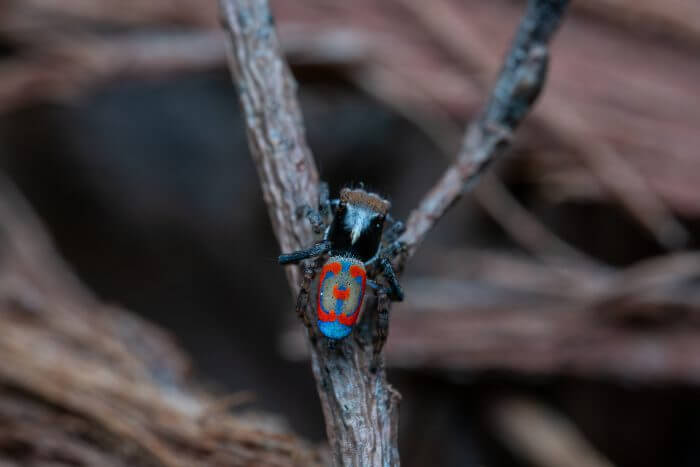
It’s worth noting that the colors on the Blue Face Peacock Spider aren’t just about pigments. The white, cream, and red scales have an intricate shape with numerous spines, which are pigmentary. However, the blue scales are unpigmented, which contributes to their unique appearance
| Scientific name: | Maratus Volans |
| Habit: | Native to Australia and can be found in a wide range of habitats |
| Size: | Both sexes typically grow to around 5 mm in size |
3. Long-Jawed Orb Weaver
The Long-Jawed Orb Weaver, known scientifically as (Opadometa Sarawakensis), has a unique and distinctive appearance that sets it apart from many other spider species. One of the most noticeable features of this spider is its elongated jaws and red and blue abdomen.
What sets this species apart from other weaver species is their striking, vibrant red and blue coloration located on their abdomen. This vibrant coloration is not commonly seen in other spiders making it easy to identify at a glance.
But there’s more to this spider than just its appearance. The Long-Jawed Orb Weaver has a fascinating web-spinning ability that allows it to capture its prey with ease.
Their long jaws, as their name suggests, are specially adapted for this purpose.
The bodies of Long-Jawed Orb Weavers are typically elongated and slender, often exhibiting a metallic sheen.
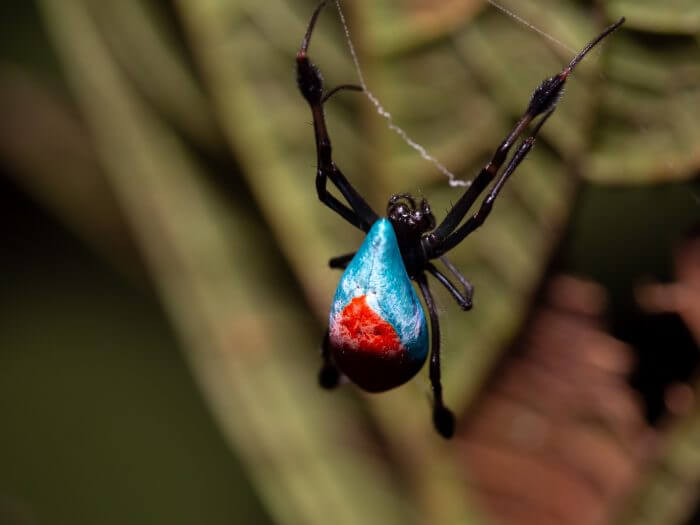
The body length differs among species, but most tend to be between 7 to 8.1 millimeters long. In addition, these spiders have eight eyes arranged in two rows.
However, despite having multiple eyes, their vision is not very sharp and they rely more on vibrations to detect their prey or sense any potential threats.
| Scientific name: | Opadometa Sarawakensis |
| Habit: | Can be found on low-hanging branches by rivers, lakes, and swamps |
| Size: | Can grow up to 8.1 mm in lengh |
4. Pink Toe Tarantula
The pink-toe tarantula, scientifically known as (Avicularia avicularia), is an arboreal species hailed for its distinctive coloration. This species undergoes a significant transformation in appearance as it matures from a spiderling to an adult tarantula.
As juveniles, pink-toe tarantulas have a predominantly pinkish body apart from their dark-colored feet. They start as a bright electric blue baby and eventually transition into a more mature color palette. As their color becomes more vibrant their hairs go almost red in color before turning pink giving them the appearance of a red and blue color.
Upon reaching adulthood, the pink-toe tarantula boasts a dark-colored body with pinkish feet, which is the key feature that gives this species its name.
The mature tarantula’s body can range from dark black or blue to metallic gray, sometimes with deep violet to reddish hues on the abdomen.
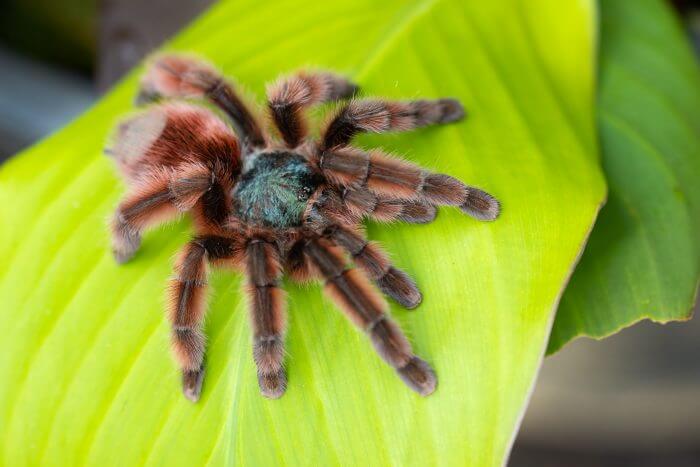
The Pink Toe Tarantula can be found in parts of Venezuela, Guyana, Suriname, French Guiana Trinidad and Tobago Peru, Bolivia, and Brazil.
This spider is definitely a fascinating creature, not just because of its interesting behavior and docile temperament, but also due to its unique and dynamic color changes throughout its life cycle.
| Scientific name: | Avicularia Avicularia |
| Habit: | These species are typically found in rainforest regions |
| Size: | Can grow up to six inches in length |
Related Articles:
5. Chrysilla Volupe
The Chrysilla volupe is a captivating species of jumping spider that belongs to the Salticidae family. This species is native to a range of Asian countries, including India, Sri Lanka, China, and Vietnam.
The appearance of the Chrysilla volupe is quite striking and unique and exhibits a variety of bright colors, including shades of green, blue, and of course red.
This colorful display is often accented by patterns of black and white, which add an extra layer of visual intrigue.
The body shape of the Chrysilla volupe is also quite distinctive. Like other jumping spiders, it has a compact, sturdy body and short, robust legs.
Its eyes are large and prominent, giving it excellent vision for hunting and navigating its environment.
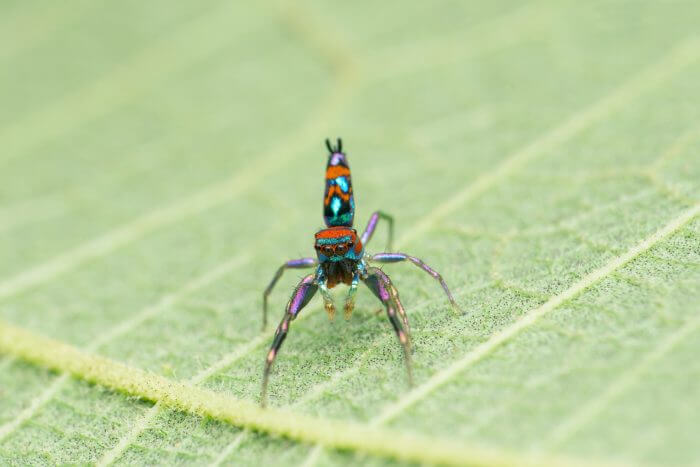
It’s worth noting that, like many other spider species, the coloration and appearance of the Chrysilla volupe can vary somewhat depending on factors such as age, sex, and geographical location.
| Scientific name: | Chrysilla volupe |
| Habit: | Found in Sri Lanka, India, Nepal, and Bhutan. |
| Size: | They can grow up to 4mm in lengh |
6. Red And Blue Widow Spider
The Red and Blue Widow Spider, known scientifically as (Latrodectus hesperus), is a patented and genetically modified species of spider from the genus Latrodectus.
This genus also includes other notable species such as the Southern Black Widow and the Northern Black Widow. These species are typically black-bodied and may exhibit various red or white markings.
A species related to the Red and Blue Widow Spider is the Red Widow, or Latrodectus bishopi, which is one of the main types of venomous spiders found in Florida.
Its bite can result in the formation of a reddish blister, surrounded by a bluish area with a narrow whitish separation.
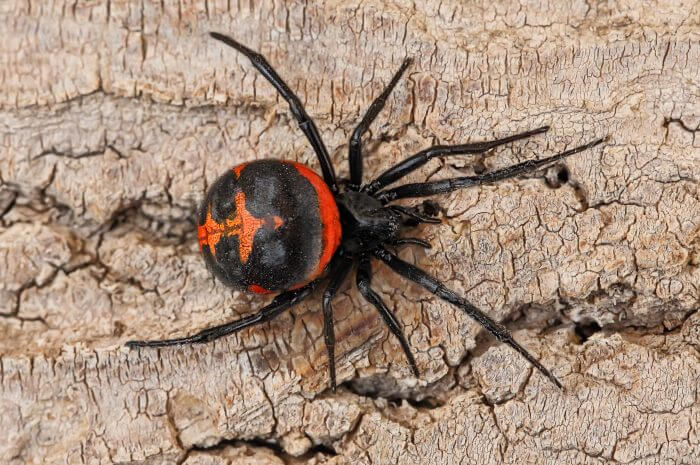
Another Latrodectus species is the Brown Widow Spider, or Latrodectus geometricus, characterized by its brick-red coloration.
| Scientific name: | Latrodectus hesperus |
| Habit: | Found throughout North America, Canada, British Columbia, and Manitoba |
| Size: | Can grow up to 14–16 mm (1/2 in) in length |
How Rare Are Red And Blue Spiders
Red and blue spiders are indeed quite rare! The red-and-blue widow spider, for instance, is a genetically modified species and not naturally occurring. Meanwhile, the Red-headed Mouse Spider, which features a bright red head and a blue-to-black abdomen, is typically native to Australia.
Overall, red, and blue spiders are no common sight. So encountering one of these brilliantly hued arachnids in the wild would definitely leave a lasting impression to anyone lucky enough to spot them.
Are Red And Blue Spiders Poisonous?
So what if you are lucky enough to encounter one of these red and blue spiders? are they poisonous? The short answer is yes! Red and blue spiders, like most spiders, are indeed venomous, but the level of toxicity varies greatly among species.
The Red-headed Mouse Spider, for example, is known to produce a large amount of highly toxic venom that could potentially be as dangerous as that of the Sydney Funnel-web Spider. However, it’s important to note that not all bites result in venom being injected.
On the other hand, while the majority of blue spiders are not poisonous, some species can deliver a bite that causes discomfort. So always proceed with caution when approaching one of these spiders.
Conclusion
So there you have 6 unique red and blue spiders! If you enjoyed this article don’t forget we have plenty more like this one simply click on the links for related articles or head over to our home page. Thanks for reading!
Related Articles:



